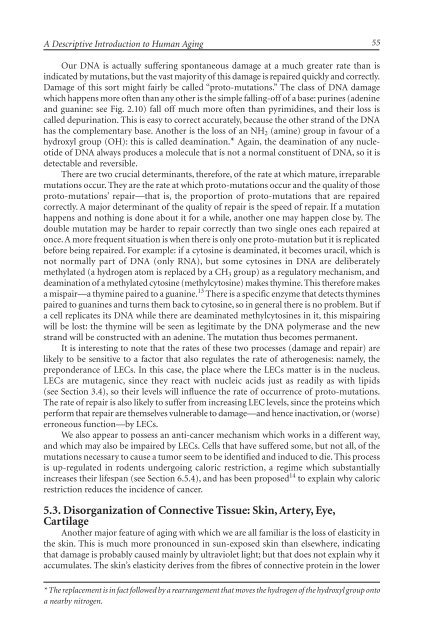The Mitochondrial Free Radical Theory of Aging - Supernova: Pliki
The Mitochondrial Free Radical Theory of Aging - Supernova: Pliki
The Mitochondrial Free Radical Theory of Aging - Supernova: Pliki
You also want an ePaper? Increase the reach of your titles
YUMPU automatically turns print PDFs into web optimized ePapers that Google loves.
A Descriptive Introduction to Human <strong>Aging</strong><br />
Our DNA is actually suffering spontaneous damage at a much greater rate than is<br />
indicated by mutations, but the vast majority <strong>of</strong> this damage is repaired quickly and correctly.<br />
Damage <strong>of</strong> this sort might fairly be called “proto-mutations.” <strong>The</strong> class <strong>of</strong> DNA damage<br />
which happens more <strong>of</strong>ten than any other is the simple falling-<strong>of</strong>f <strong>of</strong> a base: purines (adenine<br />
and guanine: see Fig. 2.10) fall <strong>of</strong>f much more <strong>of</strong>ten than pyrimidines, and their loss is<br />
called depurination. This is easy to correct accurately, because the other strand <strong>of</strong> the DNA<br />
has the complementary base. Another is the loss <strong>of</strong> an NH2 (amine) group in favour <strong>of</strong> a<br />
hydroxyl group (OH): this is called deamination.* Again, the deamination <strong>of</strong> any nucleotide<br />
<strong>of</strong> DNA always produces a molecule that is not a normal constituent <strong>of</strong> DNA, so it is<br />
detectable and reversible.<br />
<strong>The</strong>re are two crucial determinants, therefore, <strong>of</strong> the rate at which mature, irreparable<br />
mutations occur. <strong>The</strong>y are the rate at which proto-mutations occur and the quality <strong>of</strong> those<br />
proto-mutations’ repair—that is, the proportion <strong>of</strong> proto-mutations that are repaired<br />
correctly. A major determinant <strong>of</strong> the quality <strong>of</strong> repair is the speed <strong>of</strong> repair. If a mutation<br />
happens and nothing is done about it for a while, another one may happen close by. <strong>The</strong><br />
double mutation may be harder to repair correctly than two single ones each repaired at<br />
once. A more frequent situation is when there is only one proto-mutation but it is replicated<br />
before being repaired. For example: if a cytosine is deaminated, it becomes uracil, which is<br />
not normally part <strong>of</strong> DNA (only RNA), but some cytosines in DNA are deliberately<br />
methylated (a hydrogen atom is replaced by a CH3 group) as a regulatory mechanism, and<br />
deamination <strong>of</strong> a methylated cytosine (methylcytosine) makes thymine. This therefore makes<br />
a mispair—a thymine paired to a guanine. 13 <strong>The</strong>re is a specific enzyme that detects thymines<br />
paired to guanines and turns them back to cytosine, so in general there is no problem. But if<br />
a cell replicates its DNA while there are deaminated methylcytosines in it, this mispairing<br />
will be lost: the thymine will be seen as legitimate by the DNA polymerase and the new<br />
strand will be constructed with an adenine. <strong>The</strong> mutation thus becomes permanent.<br />
It is interesting to note that the rates <strong>of</strong> these two processes (damage and repair) are<br />
likely to be sensitive to a factor that also regulates the rate <strong>of</strong> atherogenesis: namely, the<br />
preponderance <strong>of</strong> LECs. In this case, the place where the LECs matter is in the nucleus.<br />
LECs are mutagenic, since they react with nucleic acids just as readily as with lipids<br />
(see Section 3.4), so their levels will influence the rate <strong>of</strong> occurrence <strong>of</strong> proto-mutations.<br />
<strong>The</strong> rate <strong>of</strong> repair is also likely to suffer from increasing LEC levels, since the proteins which<br />
perform that repair are themselves vulnerable to damage—and hence inactivation, or (worse)<br />
erroneous function—by LECs.<br />
We also appear to possess an anti-cancer mechanism which works in a different way,<br />
and which may also be impaired by LECs. Cells that have suffered some, but not all, <strong>of</strong> the<br />
mutations necessary to cause a tumor seem to be identified and induced to die. This process<br />
is up-regulated in rodents undergoing caloric restriction, a regime which substantially<br />
increases their lifespan (see Section 6.5.4), and has been proposed 14 to explain why caloric<br />
restriction reduces the incidence <strong>of</strong> cancer.<br />
5.3. Disorganization <strong>of</strong> Connective Tissue: Skin, Artery, Eye,<br />
Cartilage<br />
Another major feature <strong>of</strong> aging with which we are all familiar is the loss <strong>of</strong> elasticity in<br />
the skin. This is much more pronounced in sun-exposed skin than elsewhere, indicating<br />
that damage is probably caused mainly by ultraviolet light; but that does not explain why it<br />
accumulates. <strong>The</strong> skin’s elasticity derives from the fibres <strong>of</strong> connective protein in the lower<br />
* <strong>The</strong> replacement is in fact followed by a rearrangement that moves the hydrogen <strong>of</strong> the hydroxyl group onto<br />
a nearby nitrogen.<br />
55


